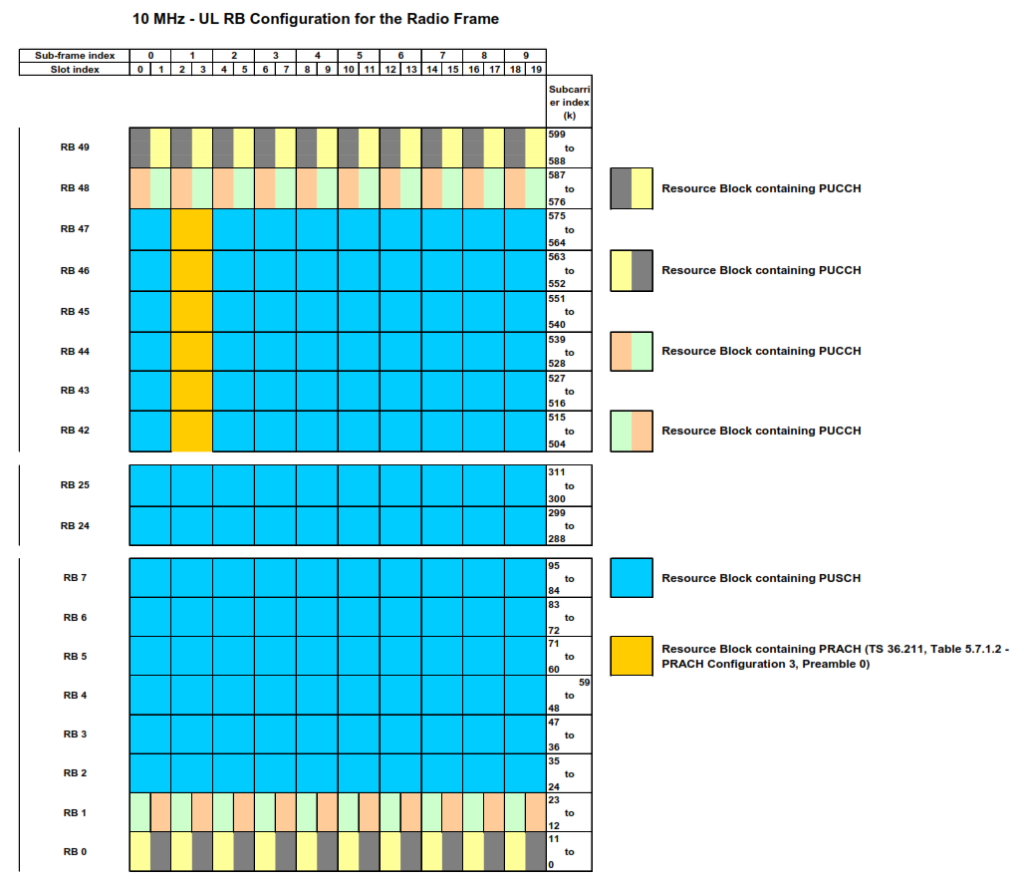Uplink throughput in LTE refers to the rate at which data is successfully transmitted from the User Equipment (UE) to the eNodeB (base station). Achieving high uplink throughput is critical for applications such as video conferencing, live streaming, and cloud-based services, where large amounts of data need to be sent from the user to the network.
The uplink PUCCH, PRACH, and PUSCH regions are statically configured and are changed via SIB only. The following figure illustrates a configuration for a 10 MHz channel bandwidth.

Note: This figure is for illustrative purposes only. The PUCCH size and PRACH configuration are configurable.
PUCCH.
The PUCCH carries uplink control information including CQI, HARQ ACK/NACKS, and UL scheduling requests. L1/L2 control signaling is mapped to the uplink resource blocks at the carrier band edges so as to maximize the frequency diversity for control signaling. The PUCCH is never transmitted simultaneously with the PUSCH from the same UE.
PUCCH is transmitted in every uplink subframe. Its size is specified via the database parameter “pucchSize” which indicates the number of resource block pairs allocated to the PUCCH within a subframe. In Figure above, the resource block pairs are color-coded with each color (grey, yellow, light green, and light orange) representing a unique resource block pair. Note that each resource block pair undergoes inter-slot frequency hopping. Default suggested sizes vary with the channel bandwidth as follows: 4 (for 5 MHz), 8 (for 10 MHz) or 10 (for 20 MHz).
PRACH.
The PRACH carries the random access preambles and is used by non-synchronized mobiles for initial access, handover, UL synchronization, and UL SCH resource requests. Each PRACH occupies 6 RBs (i.e. 72 subcarriers) for a subframe and is located in a region adjacent to the PUCCH. Sixteen predefined random access slot configurations allow for specifying the number of PRACH channels and their location (i.e. which subframes in which they appear).
The range of PRACH per frame include:
1/2 (i.e. every other frame), 1, 2, 3, 5, and 10. The default configuration is #3 which allocates 1 PRACH per frame located in subframe 1 (as depicted in Figure above). Assuming the default for 5 MHz, this only accounts for an additional 2.4% in overhead (which scales down to 1.2% and 0.6% for 10 and 20 MHz, respectively).
The default configuration is expected to be sufficient for the majority of cases. However, a typical “hot-spot” sites may need to be configured with more than 1 PRACH per frame.
Reference Signals.
Two types of uplink reference signals are supported:
- Demodulation reference signals (DRS) are used for channel estimation within the eNodeB. It is used for both data and control signaling. It is located in the 4th symbol (for normal CP) of each slot across all subcarriers. The presence of DRS will consume ~14% (1/7) of PUSCH capacity.
- Sounding reference signals (SRS) are used to control frequency-dependent scheduling by the eNodeB. SRS is used to support features such as UL Frequency Selective Scheduling (FSS) and transmission mode 7 (i.e. open loop DL beamforming). The SRS will be located in the last symbol of the subframe. When present, it would conservatively be estimated to consume ~7% (1/14) of PUSCH capacity. The sounding reference signal (SRS) is not associated with either the PUCCH or PUSCH.
- Note that neither DRS nor SRS are depicted in Figure above.
PUSCH.
The PUSCH carries uplink data and higher layer signaling. It is a shared channel allocated to different UEs periodically, usually every 1 ms. The channel coding, modulation, and subcarrier allocation is dynamically controlled by the PDCCH.
Table below shows the number of RBs per slot (RB pairs per subframe) available for PUSCH allocation after discounting for PUCCH and PRACH. For example, when 10 MHz is assumed, there are 50 RBs (refer to Table – Frequency Domain Numerology) from which we subtract 8 for PUCCH (suggested sizing) for a total of 42. If the subframe has a PRACH, then 6 more RBs should be discounted.

Using the information provided within this article, an estimate of PUSCH throughput in terms of resource elements per frame can be derived. Table below shows the estimate for
a 10 MHz bandwidth assuming 8 RBs for PUCCH, 1 PRACH, and SRS employed. The resulting 54,648 PUSCH REs/frame (or 5.465 MREs/second) reflect ~35% (= 100% – 65.1%) overhead which is constituted primarily of control signaling (~16%) and reference signaling (~18%). The spreadsheet that was used to derive these values was careful not to double-count the overlap between reference signals and any other channels. The example below would improve by ~6% if SRS were not assumed.

Note: In the table, symbols refers to REs, frequency blocks refers to RBs, and scheduled resource blocks refers to RB pairs.
A spreadsheet (LTEBasicTput.xls) employing these calculations can be found at http://compass.mot.com/go/lteplan in the LTE RF Planning Guide folder. Table below shows the percent of the frame to be allocated for the PUSCH for varying bandwidth. The table assumes the default PUCCH sizing, 1 PRACH, and SRS employed.
